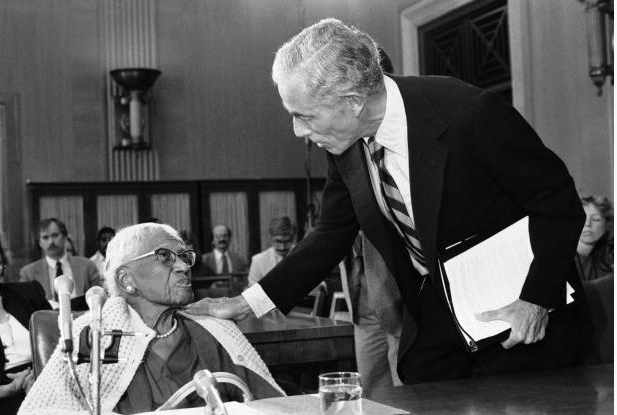Labor: The First Black-Led Union Wouldn’t Have Existed Without this Woman
June 19, 2018
by Meagan Day | Portside
Pullman porters formed the first black-led union to be recognized by the American Federation of Labor— and Rosina Tucker became one of the most influential female labor and civil rights organizers in American history.

Senator Claiborne Pell talks to 103-year-old Rosina Tucker at a a hearing of the Senate Aging subcommittee of Labor and Human Resources in 1984. , Scott Stewart/AP Photo
Rosina Corrothers Tucker was born in 1881 in Washington, D.C. She married a preacher, and might have lived a quiet life, except the preacher died, and when she remarried it was to a man whose job put the couple in just the right place and time to make history.
Rosina’s husband Berthea Tucker was a Pullman porter. In the 1920s, the Pullman Palace Car Company was the nation’s largest single employer of black men. Pullman porters formed the first black-led union to be formally recognized by the American Federation of Labor, and eventually led the charge on civil rights — and Rosina Tucker became one of the most influential female labor and civil rights organizers in American history.
George Pullman started the Pullman Palace Car Company in 1862. He was a pioneer in vertical integration: he not only built the cars but operated them. And he brought the same approach to personnel matters, building and maintaining a company town in Illinois for his workers to live in and company stores for them to buy from.
His business was a massive success, but its profit model relied largely on cutting labor costs, which led to widespread worker dissatisfaction. Sometimes he even neglected to pay his workers enough to afford rent on properties of which he himself was the landlord. In the 1890s, nearly starving after a round of wage cuts, Pullman workers staged a massive strike that rocked the city of Chicago. Protests were chaotic, and federal troops were called in to violently suppress the strikers. Other workers across the country went on strike in solidarity with the Pullman workers, and the labor stoppage and property damage cost Pullman a fortune.
If Pullman didn’t detest unions before the 1894 strike, he certainly did afterwards. Since there were no black unions at that point, Pullman favored hiring black porters for his passenger railway cars. Soon Pullman became the largest employer of black men in the U.S., and none of them were unionized.
But by the 1920s, black labor organizer A. Philip Randolph was determined to change that. In 1921, he started laying the groundwork for the Brotherhood of Sleeping Car Porters (BSCP), which eventually became the first black-led union to sign a contract with a major U.S. corporation.
The road was rough at first. Not only were many black men unaccustomed to being in unions, having sometimes been neglected or rejected by the majority-white labor movement, but Pullman’s company had a habit of surveilling, harassing, and retaliating against union activists. Sleeping car porters faced miserable working conditions and were routinely exploited by management, but even so, working for Pullman was one of the best employment opportunities for black men in those days, and workers were understandably reluctant to stick their necks out.
The men would need to organize in secret, ideally through messengers who would pass unnoticed by management. Not only that, but they would need to be reassured constantly that being part of a union would be in their best interests. Randolph realized that in order to create a culture of solidarity and courage, as well as to perform basic tasks like communicating without being busted by the boss, the organizing effort required participation of not just men but women.
Randolph took an immediate liking to Rosina Tucker when they met in Washington, D.C., in the early 1920s. Berthea had joined Randolph’s fledgling union, but like many members he was flying under the radar out of fear of retaliation. Randolph soon enlisted Rosina to help with organizing activities.
Initially, she was brought in to deliver messages between union men. “I was asked to act as a liaison between Mr. Randolph and the Washington division,” she later explained. “Material was sent to me and I personally disseminated it to the men. I kept them in touch with what was going on, because it was dangerous for them to let it be known even to each other that they were members or had expressed any interest in the Brotherhood.”
The Pullman company didn’t suspect Rosina Tucker at first, even though she increasingly performed union business right under their noses. Pretending to make strictly social house calls to other Pullman wives, Rosina would bring union literature for dissemination and collect dues, all by way of her handbag. With Randolph’s encouragement, she began to make a dedicated effort to convince the wives of Pullman porters of the importance of the union, so that they would encourage their husbands to join, or to remain despite the risks involved. She wrote later that she believed it was politically strategic and necessary “that Pullman porters’ wives be cognizant of their husbands’ working conditions. The porter’s home had to be a union home. Without a union home, the porter could not be a good union man.”
But she wasn’t able to lay low forever. Eventually news spread about a black woman labor organizer in Washington, D.C., and Pullman managers caught wind of the rumor that Rosina Tucker was their woman. The company fired Berthea on the spot. In a rage, Rosina marched down to Union Station and confronted the company’s regional director. He asked her, “Why are you taking it up?” and she answered, “I am here because you brought me into it. If you don’t take care of this matter, I will be back.” Berthea was reinstated at the company the very next day.
After that, she conducted her business out in the open. It was written in the union paper Black Worker that she “went up and down the streets of Washington and into the offices of the Washington Pullman adviser and spoke her piece about the right of porters to join the Brotherhood.”
In 1925, six weeks after the Brotherhood of Sleeping Car Porters became official, Tucker founded and became president of the Ladies’ Auxiliary, also known as the Women’s Economic Councils. This was a formal way to do what she’d been doing already: organizing for the porters’ union, including organizing the porters’ wives and families. Instead of secret house visits, the Women’s Economic Councils held meetings out in the open, and had a full calendar of social and educational programs for everyone in the extended world of the union.
But under Tucker, the Women’s Economic Councils offered much more than moral support to the BSCP. Other African American trade union women, such as Halena Wilson, believed that the ideal role of the Ladies’ Auxiliary was to support the union so that the men could bring home as much bacon as possible. Wilson’s image of the union housewife was someone who “enjoyed the domestic security of her husband’s union wages and used her power as a consumer to buy union-made goods.” Tucker disagreed — she felt that it was important for the Women’s Economic Councils to actively participate in organizing women workers, too, and she pushed the group to do exactly that.
The Women’s Economic Councils formed connections with labor unions — black and white, women’s and men’s — throughout D.C. When the Washington Women’s Trade Union League (WTUL) and the National Negro Alliance called for a protest against racial discrimination in the grocers’ trade, Tucker helped organize the boycott. From there, the Women’s Economic Councils began to support the WTUL in “organizing unions for laundry workers, domestic workers, and hotel and restaurant workers, all largely African American women’s occupations.” And whenever there was an anti-racist or civil rights fight to be picked, the Women’s Economic Councils were on the front lines.
After eleven years of Tucker’s leadership, the Women’s Economic Councils gave her a token of appreciation for her service: a beautiful briefcase. The symbolism of the gift was intentional. Tucker had always insisted that the Women’s Economic Councils were not a charity or a hobby: they were a tool of collective political struggle. The briefcase was an acknowledgment of Tucker’s seriousness and dedication — she meant business.
Tucker remained a close friend and accomplice to A. Philip Randolph for decades. When Randolph organized the first civil rights march on Washington, in 1941, he relied on Tucker as a key organizer. The march was called off, but only after the threat of hundreds of thousands of black people descending on D.C. had succeeded in pressuring President Franklin D. Roosevelt to ban racial discrimination in the defense industry, which eventually led to the desegregation of the military.
And when Randolph organized the second March on Washington, in 1963, hecalled on Tucker that time as well. She was 82 years old. She died in 1987, at 105 years old, after a century of struggle. She had been a mourner at the funeral of Frederick Douglass and was present when Martin Luther King Jr. delivered his “I Have a Dream” speech. After her death, an unfinishedautobiography was found in which she wrote, “Today is my day, as it is your day. Although I live far removed from the time when I was born, I do not feel that my heart should dwell in the past. It is in the future. While I live, let not my life be in vain. And when I depart, may there be remembrance of me and my life as I have lived it.”

